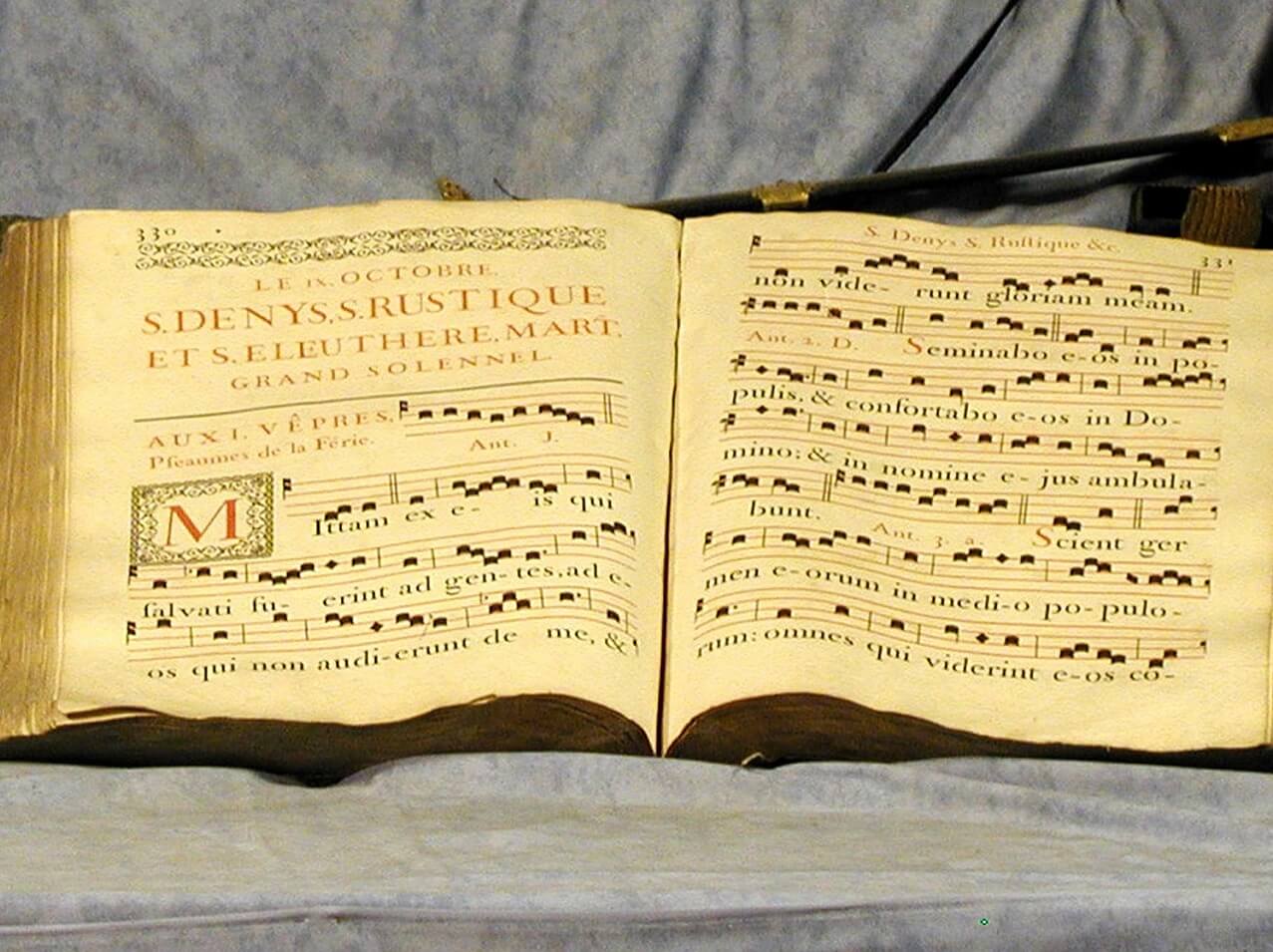I wanted to learn how to chant. Those inky little square notes zigzagging across the four-line staff were as exciting to me as the markings on a pirate treasure map. My first attempts were in large scholas in which experienced chanters guided the whole group the same way foreign guides shepherd timid tourists: they know the native dialect, and they keep everyone out of the sticky spots that one often encounters in foreign travel. We had only to follow our fearless guides as they sang the right pitches and kept the melody flowing.
One day I found myself in a small schola without the usual guides. It didn’t take long before rough gangs of neumes smelled my fear and closed in around me under menacing modal skies. I could hardly defend myself because I knew nothing of the land or the dialect. By some miracle, I survived the ordeal, but those Solesmes bandits left me (or at least my pride) black and blue all over. That very day, I resolved to cast aside my tourist visa and apply for dual citizenship. It was time for me to learn the land.

Although I could read anything on the five-line staff in either treble or bass clef, the four-line staff with its ancient do and fa clefs had me stumped. I would sit down at a piano with a piece of chant and try to plunk out the “tune” of the thing, but the result was a jumbled string of notes that could have won a prize in modern music for “Most Innovative Dissonance of the Year.”

At some point, I heard that Gregorian chant is based on the diatonic scale, a scale that always has two half steps. I realized that my melody never sounded right because I was treating every step as a whole step. “Fair enough!” I thought. “Where are the half steps?” In modern notation, one knows very well that, for the key of C, the half steps are between E and F and B and C. In other keys, one need only look to the signature with its sweet little flats that look like half hearts on stems or its jaunty sharps that are what we now call hashtags and see exactly what one is up against. But chant notation has no key signature, only an accidental flat in certain modes, and no sharps at all. The chanter who foolishly sallies forth without a guide or a proper understanding of the notation stumbles over the hidden half steps and sets off veritable explosions of discord. I was determined not to be such a hapless chanter, and I fixed my mind on cracking the code.

The solution was there before me all the time in those unassuming clefs, which look so primitive compared with their ostentatious modern descendants. These clefs are like the “YOU ARE HERE” label in maps of a building floor plan. They give you a point of reference by telling you where on the staff do or fa falls. When I coupled that bit of knowledge with the realization that solfege is nothing more than the generic template for all diatonic scales with the half steps fixed at mi to fa and ti to do, things began to come into focus.
I sat down at the keyboard again and no longer plunked, but carefully played the notation as solfege. I could almost see Maria von Trapp smiling sweetly and hear her singing, “When you know the notes to sing, you can sing most anything!” [1]. She was right. It was a bit painstaking at first, but I soon realized I was playing the beautiful chant melody I was after. I stumbled occasionally, but ah! That was a ti-do just where it ought to be. Smooth going for a few more notes, and then dissonance. But of course! I had missed a sneaky fa-mi. I smiled to myself. These half steps couldn’t scare me anymore. I was on to them. The notation yielded to me more and more, and I felt my pulse quicken. It was an Eliza Doolittle, “Rain in Spain” kind of breakthrough. I realized I had crossed into a new plane of knowing. I had won my citizenship in the foreign land.
The neumes, though still fierce, allow me to travel through their lands unhindered, and I have come to terms with the modes. Like a polar explorer who marvels at the northern lights, I respect them without exactly understanding them. I still get into plenty of scrapes and misadventures. Passages of unusual intervals rise up like craggy slopes, and I must take care not to lose my footing. Bushwhacking through tangled trigons leaves me panting for breath and scanning the horizon for the nearest half bar. But I am a far cry from that uneducated child who first came to this world as a mere tourist. Each expedition I make in the wild lands orients me a little more toward the good, the true, and the beautiful, even as it humbles me and shows me my human limitations.

No matter how much I explore the world of Gregorian chant, I will never exhaust its treasures. It will go on yielding its unsurpassed fruits to anyone willing to make the effort to traverse its beautiful, wild terrain.

All Gregorian chant images taken from The Liber Usualis 1961 Edition. DESCLEE COMPANY. Printers to the Holy See and the Sacred Congregation of Rites. TOURNAI (Belgium) — NEW YORK, N.Y. (Digital version courtesy of Church Music Association of America MusicaSacra.com.) All modern notation images taken from Wikimedia Commons.
[1] Richard Rodgers and Oscar Hammerstein II, “Do-Re-Mi,” 1959.


